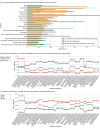Development and Validation of a Personalized Model With Transfer Learning for Acute Kidney Injury Risk Estimation Using Electronic Health Records
- PMID: 35796212
- PMCID: PMC9250052
- DOI: 10.1001/jamanetworkopen.2022.19776
Development and Validation of a Personalized Model With Transfer Learning for Acute Kidney Injury Risk Estimation Using Electronic Health Records
Erratum in
-
Errors in the Supplement.JAMA Netw Open. 2022 Aug 1;5(8):e2232183. doi: 10.1001/jamanetworkopen.2022.32183. JAMA Netw Open. 2022. PMID: 36040747 Free PMC article. No abstract available.
Abstract
Importance: Acute kidney injury (AKI) is a heterogeneous syndrome prevalent among hospitalized patients. Personalized risk estimation and risk factor identification may allow effective intervention and improved outcomes.
Objective: To develop and validate personalized AKI risk estimation models using electronic health records (EHRs), examine whether personalized models were beneficial in comparison with global and subgroup models, and assess the heterogeneity of risk factors and their outcomes in different subpopulations.
Design, setting, and participants: This diagnostic study analyzed EHR data from 1 tertiary care hospital and used machine learning and logistic regression to develop and validate global, subgroup, and personalized risk estimation models. Transfer learning was implemented to enhance the personalized model. Predictor outcomes across subpopulations were analyzed, and metaregression was used to explore predictor interactions. Adults who were hospitalized for 2 or more days from November 1, 2007, to December 31, 2016, were included in the analysis. Patients with moderate or severe kidney dysfunction at admission were excluded. Data were analyzed between August 28, 2019, and May 8, 2022.
Exposures: Clinical and laboratory variables in the EHR.
Main outcomes and measures: The main outcome was AKI of any severity, and AKI was defined using the Kidney Disease: Improving Global Outcomes serum creatinine criteria. Performance of the models was measured with area under the receiver operating characteristic curve (AUROC), area under the precision-recall curve, and calibration.
Results: The study cohort comprised 76 957 inpatient encounters. Patients had a mean (SD) age of 55.5 (17.4) years and included 42 159 men (54.8%). The personalized model with transfer learning outperformed the global model for AKI estimation in terms of AUROC among general inpatients (0.78 [95% CI, 0.77-0.79] vs 0.76 [95% CI, 0.75-0.76]; P < .001) and across the high-risk subgroups (0.79 [95% CI, 0.78-0.80] vs 0.75 [95% CI, 0.74-0.77]; P < .001) and low-risk subgroups (0.74 [95% CI, 0.73-0.75] vs 0.71 [95% CI, 0.70-0.72]; P < .001). The AUROC improvement reached 0.13 for the high-risk subgroups, such as those undergoing liver transplant and cardiac surgery. Moreover, the personalized model with transfer learning performed better than or comparably with the best published models in well-studied AKI subgroups. Predictor outcomes varied significantly between patients, and interaction analysis uncovered modifiers of the predictor outcomes.
Conclusions and relevance: Results of this study demonstrated that a personalized modeling with transfer learning is an improved AKI risk estimation approach that can be used across diverse patient subgroups. Risk factor heterogeneity and interactions at the individual level highlighted the need for agile, personalized care.
Conflict of interest statement
Figures





